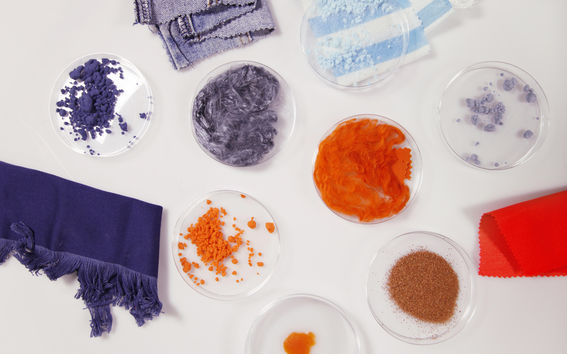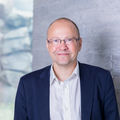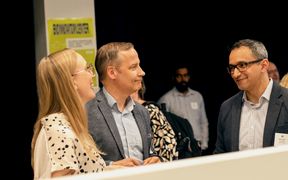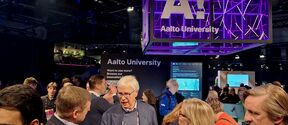Speeding up the textile revolution with Ioncell®


Antti Rönkkö, CEO and Co-Founder of Ioncell Oy:
‘This is an energising time – it’s fantastic to be building up a new company and help solve the textile industry’s huge sustainability challenges.
I previously worked as Nanso Group’s CEO. The leap to Ioncell was not as big as you might think. Although Nanso is an old and strong Finnish clothing brand, the company behind it is rather small and has many similar characteristics as a startup, including agile way-of-working and low hierarchy. Even as the CEO, I may have considered the company strategy, then filled out Excel documents and maybe even swept the trash off the floor.
At Ioncell Oy, my main task is to turn a unique technology into a lucrative business. The first major step is finding investors. Until now, Ioncell has been a research project above all; from now on, all development work will be done on commercial terms. We also need to build a team, create an organisational culture and deal with a variety of practical matters, from finding office spaces to organising healthcare.
Ioncell Oy has all the makings of becoming a successful company. The textile industry needs to change: 110 million tonnes of textile fibres are produced each year globally. 99 per cent of the production is linear, which means materials are not recycled into new fibres. Virgin materials are used to make clothes that last a moment and then are tossed into the trash or burned as energy. I’m sure in ten years’ time, our children will be asking how this waste of natural resources was even possible.
We can manufacture high-quality fibres from wood or recycled textiles, producing something stronger than virgin cotton, and these fibres can be recycled multiple times. The value of the global textile fibre market is around 200 billion euros annually. We are aiming for a 5–10 per cent market share, which would bring us hundreds of millions of euros in annual licensing income. We’re not competing with price but with sustainability and quality.’

Herbert Sixta, Emeritus Professor and one of the creators of Ioncell® technology, Co-Founder of Ioncell Oy:
‘It takes a lot of time, hard work and money to commercialise technology like Ioncell®.
The technology has been proven to work in a laboratory and short shifts on pilot production lines. The next development step is to produce fibres in a continuous closed-loop mode, ensuring that the solvent is recycled nearly 100 percent and the recycling process is integrated into the manufacturing process – this is a firm requirement to ensure ecological and financial feasibility. After that, a larger demo facility will be constructed.
Ioncell’s strength lies in the high quality of the resulting fibre, which is based on optimally using the qualities of cellulose molecules. Cellulose is very strong – trees and other plants made of the material can endure extreme conditions. The air-gap spinning process, using an ionic liquid as a solvent, allows the fibres’ cellulose molecules to align in parallel, which gives the fibres its strength.
Ioncell® was created at Aalto University, and the collaboration with students and researchers continues to be strong. We need other expertise, as well. For example, the head of technology, who is in charge of production, needs to have solid experience in the textile industry and its requirements.’

Janne Laine, Vice President for Innovation at Aalto University:
‘The university has typically received shares in startups in exchange for the transfer of immaterial rights. Now, for the first time, we decided to become a co-founder.
Our experience with startups’ early-stage needs and challenges goes a long way back. Ioncell® is a promising technology, in which Aalto has made large investments. We want to do our best to ensure the company gets off to a good start.
Supporting research-based entrepreneurship is a strategically important goal for us, and we will continue our active role in developing companies. At the moment, investors finance companies that focus on renewable energy, battery materials, biomaterials and other sustainable solutions, quantum technology, artificial intelligence and applications related to health technology. These are also Aalto’s key research focus areas – I would like to see more growth companies born at our university.
In the future, I hope and believe I’ll see doctoral researchers increasingly choosing startups as a career path. Deep tech companies need the latest research expertise. IQM, which stemmed from Aalto and VTT, is a prime example; it has already recruited a significant number of quantum technology doctors.’
This article has been published in the Aalto University Magazine issue 31, October 2022.
Bioinnovation Center kicked off
Aalto University Bioinnovation Center has kicked off its operations and celebrated its opening in a launching event on June 1, 2022.

Read more news

Applications for our biggest exhibition of the year are now open: Apply to Designs for a Cooler Planet by 26.1.2026!
For the autumn 2026 exhibition, we are looking for new and inspiring innovations, ideas, and experiments from all fields across Aalto University. The exhibition and its events serve as one of the most important showcases of the university’s work to the world. In 2025, the event attracted over 15,000 visitors.
Aalto at Slush: creative design and new innovations
Aalto University's Slush exhibition featured the design-based material innovation Bubbles with Benefits. The exhibition also highlighted the importance of design as a driver of technological innovation.
Research shows that creativity is not only measurable but also a major competitive advantage – the focus now turns to leadership
Creativity enables people to view problems from new perspectives and to discover solutions that might otherwise remain unseen.






